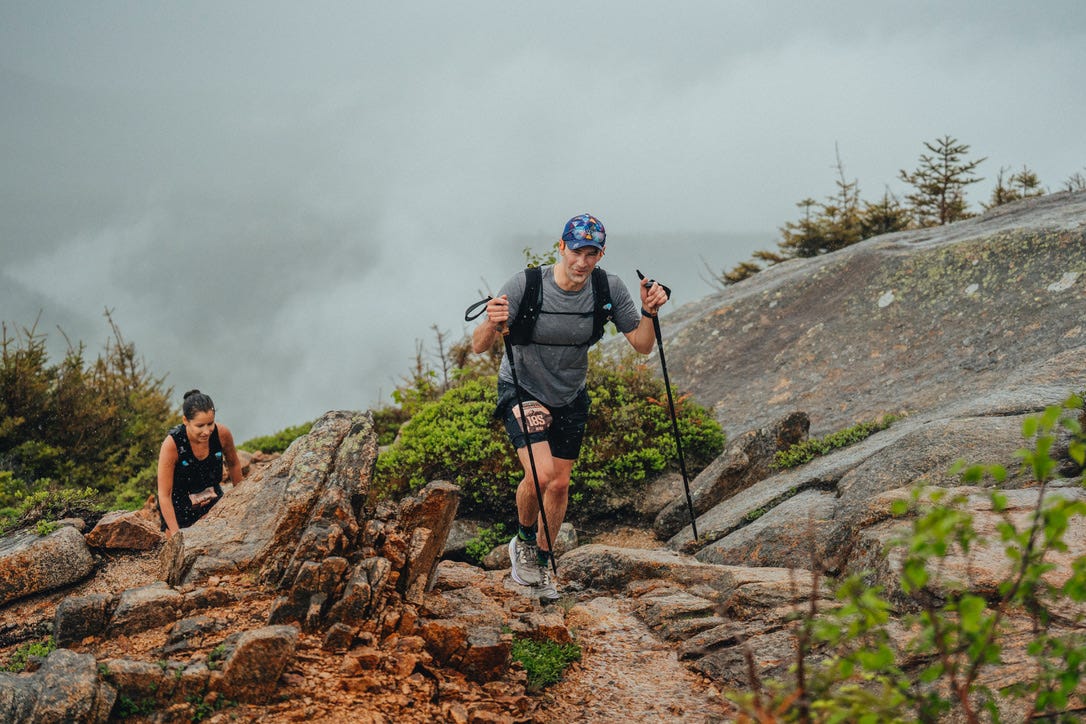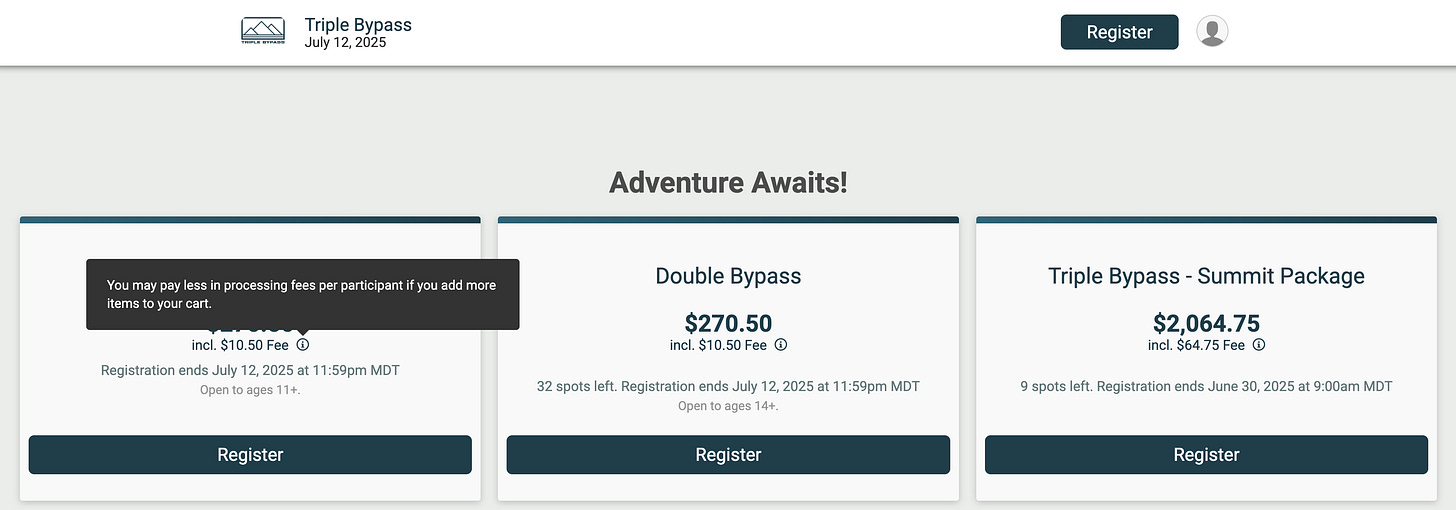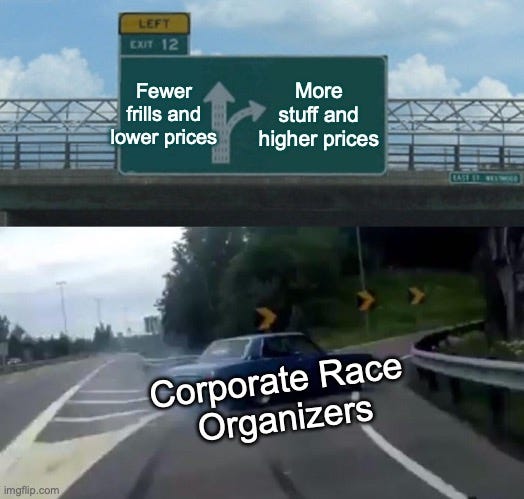Recess #13: Less is Less is More?
Investigating the rising price stratification of organized endurance events and races
Two Saturdays ago, I spent about a quarter of my waking hours fighting as fast as I could through the rain, mud, deep puddles, and slick rocks up around Chocorua Mountain in New Hampshire. A lot of things kept me moving towards the finish line: I was having fun, I wanted to finish in under four hours, and on top of it all, I paid to be there. More specifically, I paid $148.17 (including taxes) to run the 14+ mile course, that is ostensibly free to traverse otherwise (thank you NH taxpayers and local park maintenance teams). My opt-in fees covered a couple volunteer-run aid stations, a hired photographer, a free t-shirt, race chip timing, and finish line food in the form of a grain bowl and ice cream. The event was equal parts expensive and entertaining despite the very poor conditions, and guess what: I’m doing it all again in late July (hopefully with less rain)!

Above both my excitement and somewhat unveiled sarcasm hangs an overall concern about the broadly increasing costs of organized endurance racing events, be they road running, trail running, or even cycling and triathlon. In recent years entry fees have crept— or in some cases, rocketed— upward fairly ubiquitously. A flagship event like the Boston Marathon has a qualified entry fee of $230 ($100 more expensive than 2010), though it pales in comparison to more complex events like an Ironman event, which averages around $900 for entry fee alone (vs. $550 in 2010). A local 100+ mile Colorado cycling race/ride I participated in (and completed only once), the aptly-named Triple Bypass has an entry fee today of $270 compared to $150 in 2010. In all instances, the price to participate has nearly doubled in less than two decades, lowering access to the events themselves.
On average, each of these events increased in cost an average of 74% while the consumer price index (CPI) increased by ~45% in the same period. Of course, CPI does not necessarily capture cost increases in specific areas perfectly despite being the litmus for general inflation. For organized races of all kinds, the most basic requirements like permits, road closures, timing systems, web hosting, any required safety personnel, and aid station nutrition could be increasing in cost faster than CPI. Even if we assume those costs have increased at a rate similar to CPI, I still think a few distinct forces have been driving increased prices (on average) for many types of endurance races:
Increased for-profit race organization striving for higher revenues and operating margins from consolidated portfolio races
Increased participation, leading to non-linear cost increases for certain centers like logistics or race infrastructure
Proliferation of non-optional race gear unsupported by a race gear sponsor folding into the entry fee
Rising participant willingness to pay pushing the intersection of supply and demand higher up the price curve
At the 2023 Marathon du Mont Blanc, they had a live band playing mid-course! I enjoyed it as a spectator, but I’m not sure how the runners felt about it…
Most controversially, it’s been interesting to see how larger corporations have been successful in consolidating the ownership of races both in the US and internationally then driving up prices. Likely the most notable example is the World Triathlon Corporation (WTC), best known for their IRONMAN brand (that they acquired in 1989). Chinese private equity fund Dalian Wanda Group now owns WTC, and has added many other races to their portfolio, including the Rock n’ Roll marathon series, while more recently investing in trail race giant UTMB Group to much trail running community chagrin. However, beyond WTC, examples of companies growing their races and consolidating local race series abound, including Ventures Endurance, Aravaipa Running, Ourea Events, and many more. As local races get acquired, a monopoly for a locality or type of race can begin to form, and this market dominance naturally amplifies the profitability goals for these races, which most typically includes raising prices for the participants— interestingly, cutting costs has not seemed to be as popular a method to improve financial performance!
On top of companies looking to grow revenue and margin for their collection of races, it is interesting to consider how increasing participation in endurance racing can drive non-linear increases in costs. Of the basic required race/event features noted above, I would imagine that consumables like aid station nutrition, race bibs, and even web hosting capabilities scale pretty linearly with the number of participants, which wouldn’t change the per-person cost (in theory). I don’t think that infrastructure and logistics costs like road closures, traffic control, and even chip timing systems don’t scale dramatically, if at all, when the number of participants in an event increases. That leaves permits and safety personnel, both of which I could actually see scaling non-linearly, especially if there is a step-change in cost for going above certain participant thresholds. Would this impact be on the magnitude of increased prices due to financial growth requirements of the race hosts? I don’t think so, but they’re worth considering in the big picture.

My personal frustration peaks with the fact that it’s become harder, or impossible in some cases, to opt out of the set of race extras and features that are effectively non-required. Simultaneously, the variety of event perks seem to keep expanding, and can include anything from race medals to t-shirts and hats to finish meal/drink tickets, to gear bags, to after-race beer, to in-race photography to prizes for the winners. While I don’t envy race directors when it comes to selecting what parks to include or exclude from an event, it seems in recent years that the amount of swag and extras provided at events has ballooned. Certainly some of this may be driven by sponsorships from gear companies, nutrition brands, or even local business at no cost to participants, but increased entry fee certainly cover a portion of these extras. I would love to swap some of my race t-shirts for extra porta-potties at the start/finish line of some of these races. I don’t know how feasible it is, but I definitely think optional race additions should be opt-in as opposed to being a default portion of the entry cost.
Recess #7: Trying to Get a "Head" Start
If you (like me) have ever dropped off a runner at the start of a marathon or race of any notable size (i.e. greater than 50 people), you’ve seen a familiar sight. 10 minutes before the start of the race, runners either shivering from the cold or sweating from the heat stressed out of their mind standing in long lines waiting to go to the bathroom one l…
Finally, and perhaps most importantly, consumer willingness to pay for races and organized events has been rising to meet increased pricing— though it’s unclear why. It’s likely true that most endurance events including triathlons, trail races, road races, and cycling events already provided enough value that prices could rise without any pushback from consumers even if the experience remained unchanged. However, I also wonder if there have been any substantive demographics shifts towards higher-income participants that drives a higher accommodation for race prices, particularly in cost-intensive sports like triathlon and cycling. Increased demand for emerging sports like trail running can naturally increases price as well if supply of races stays the same throughout the year. In any case, it seems like endurance athletes (including myself) have coped with the price increases so far.
The convergence of rising costs, evolving expectations, and shifting consumer values is creating an interesting “product market” for amateur endurance sports events. Despite the trail running and IRONMAN triathlon communities being substantively different, both are facing the challenge of exclusively being able to attend higher-cost, more polished events. Especially for trail running, what was once a niche community gathering can often feel like a high-stakes competitive production. It’s not to say one is better than the others, and this point likely highlights a growing opportunity: a clear market gap for stripped-down, bare-bones races that cater to those who care most about the sport and experience and who garner less value from the extra additions and marginal costs of more produced events.
One great local example in Boston is the Trail Animals Running Club (TARC), who hosts trail running events throughout the year. I recently signed up for my first 50K in the TARC Fall Classic—for just $25 and I’m pumped. Will there be a professional photographer? Maybe, maybe not. Branded finisher gear or commemorative swag? Highly unlikely. And given my race entry fees throughout the first half of the years, this fits right into the appeal. I can’t say whether or not these types of fewer-frills lower-cost events actually generate a heightened sense of community as is often claimed, but I think their existence is crucial in expanding that community for a given sport, and makes you question what you’re really paying for in other races.
That, I think, exposes a fundamental tension in the modern endurance event landscape: for many races—though certainly not all—higher pricing is not just a necessary evil, it is also a result of the a race’s features— effectively its product. Having access to both models— premium and grassroots— is a healthy part of any sport’s development and popularization, but it becomes problematic when one format starts to dominate the ecosystem. If everything starts to look and cost like IRONMAN, we risk losing the quirky, DIY culture that made endurance sports so approachable in the first place, and events become inaccessible for many. The general size and growth of a sport can often be boiled down to its overall cost for participants, and shifting the cost per person can have dramatic effects in the long run— some day I will absolutely plot overall sport equipment cost against number of global participants.
But until then, it’s time to start training for a slow 50k!
There’s the bell!






